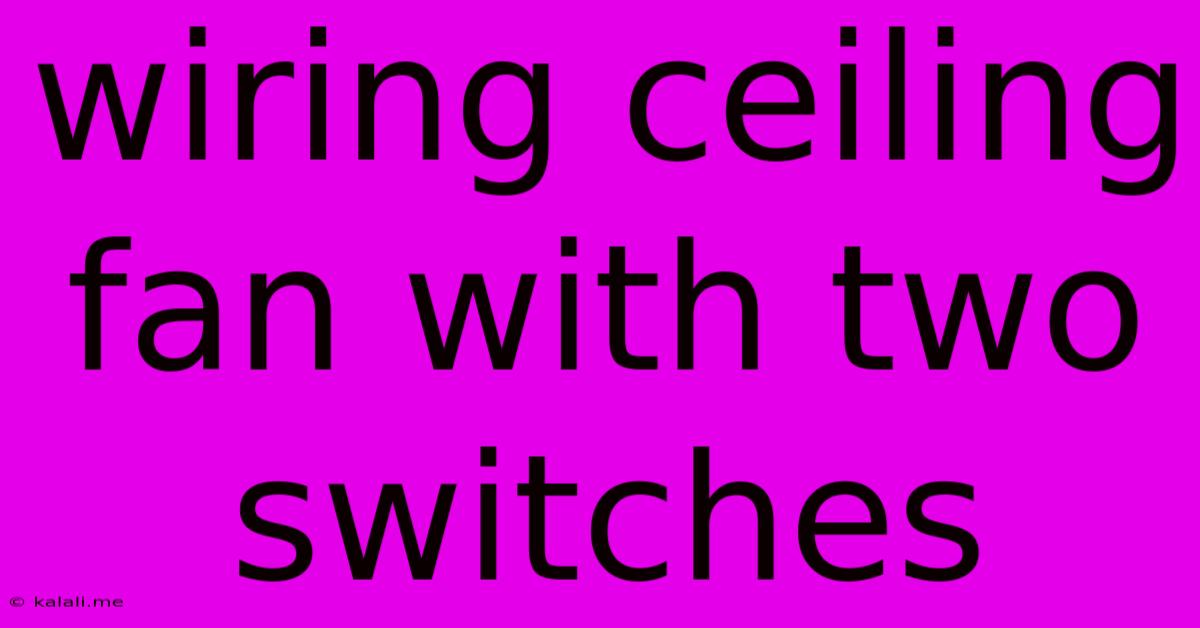Wiring Ceiling Fan With Two Switches
Kalali
May 30, 2025 · 4 min read

Table of Contents
Wiring a Ceiling Fan with Two Switches: A Comprehensive Guide
Controlling your ceiling fan's light and motor speed independently is a common desire, achieved by wiring it to two separate switches. This setup offers greater convenience and energy efficiency. This guide provides a step-by-step walkthrough, ensuring a safe and successful installation. Remember to always turn off the power at the breaker box before beginning any electrical work.
Understanding the Setup: This configuration utilizes two switches: one controlling the fan motor and the other controlling the light. This requires specific wiring within the junction box and careful connection to the switches. We'll detail the process for both 3-wire and 4-wire fan installations.
Tools and Materials You'll Need:
- Screwdrivers: Phillips and flathead
- Wire strippers/cutters: For preparing wire ends
- Voltage tester: To ensure power is off
- Wire connectors (wire nuts): For secure connections
- Electrical tape: For added insulation
- Ceiling fan: With its mounting bracket and instructions
- Two 3-way switches: These are crucial for this setup; single-pole switches won't work.
- Electrical box: Ensure it's rated for the weight of your ceiling fan.
Step-by-Step Wiring Instructions:
1. Preparing the Wires: Before starting, familiarize yourself with your ceiling fan's wiring diagram. This diagram usually indicates the function of each wire (e.g., black for hot, white for neutral, green or bare copper for ground). Carefully strip about ½ inch of insulation from the ends of all wires.
2. Connecting the Wires in the Ceiling Fan: This step varies slightly depending on whether your fan has a 3-wire or 4-wire setup.
-
3-Wire Fan (Motor and Light share a single hot wire): You will likely find a black (hot), a white (neutral), and a ground wire. Connect these wires according to your fan's instructions.
-
4-Wire Fan (Separate hot wires for motor and light): You’ll have a black wire for the light, a black wire for the motor, a white neutral wire, and a ground wire. Connect these wires according to the fan's wiring diagram. This setup allows independent control.
3. Connecting the Wires in the Junction Box: This is where the magic happens. The wiring connections in the junction box will be slightly different depending on your existing wiring setup and switch configuration. However, the basic principle remains the same; use 3-way switches to properly route power.
- Connect the Neutral Wires: Connect all white neutral wires together using a wire nut.
- Connect the Ground Wires: Connect all bare copper or green ground wires together using a wire nut.
- Connecting the Hot Wires to the Switches: This is the most intricate part and requires attention to the 3-way switch wiring configuration. Each 3-way switch will have three terminals: two common terminals and one traveler terminal. The exact connection will depend on the switch and your existing wiring, so refer to your switch's instructions for details. It commonly involves using one 'hot' wire from your power source, connecting it to the common terminals on each switch, and then using the traveler terminals to send power to the correct wires on your fan.
- Connecting the Hot Wires to the Fan: Once the switch wiring is complete, you connect the hot wires from each switch to the appropriate wire on your fan (motor or light).
4. Mounting the Fan and Switches: Once all wires are securely connected and tucked away, carefully mount the ceiling fan to the electrical box and then install the switches in their respective locations.
5. Turning the Power Back On: After ensuring all connections are secure, turn the power back on at the breaker box. Test the fan and light to verify that both the motor and light are working independently with each switch.
Troubleshooting: If the fan or light doesn’t work, double-check all wire connections. A faulty switch is another possibility. If problems persist, consulting a qualified electrician is recommended.
Important Safety Considerations:
- Always turn off the power at the breaker box before working with electrical wiring.
- Use appropriate safety equipment.
- If you are unsure about any part of this process, consult a qualified electrician.
By following these steps and taking necessary precautions, you can successfully wire your ceiling fan with two switches, enjoying the convenience and efficiency of independent control. Remember that safety should always be your top priority when working with electricity.
Latest Posts
Latest Posts
-
Postgres Grant Select On All Tables
May 31, 2025
-
Does Helium Heat Up Slow Or Quick
May 31, 2025
-
Connect A Pvc Pipe To New Sink
May 31, 2025
-
Can I Connect Red And Black Wires Together Ceiling Fan
May 31, 2025
-
How Many Powered Rails To Go Uphill
May 31, 2025
Related Post
Thank you for visiting our website which covers about Wiring Ceiling Fan With Two Switches . We hope the information provided has been useful to you. Feel free to contact us if you have any questions or need further assistance. See you next time and don't miss to bookmark.